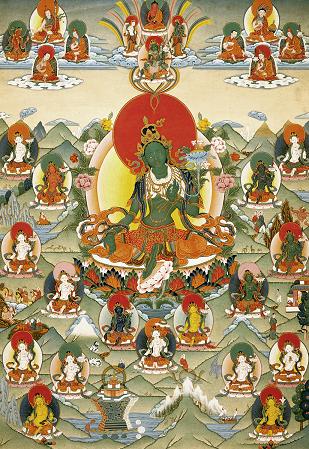Tara

Tara (Skt. Tārā; Tib. སྒྲོལ་མ་, Drolma, Wyl. sgrol ma), 'She who Liberates' — a female deity associated with compassion and enlightened activity. There are different forms of Tara, such as the Eight Taras who Protect from Fear and the Twenty-One Taras, but the most popular are Green Tara, who is associated mainly with protection, and White Tara, who is associated with longevity.
The Origin of Tara
It is said that Tara first manifested out of tears shed by Avalokiteshvara.
Sogyal Rinpoche writes in The Tibetan Book of Living and Dying:
- In his infinite compassion, [Avalokiteshvara] vowed [...] to liberate all sentient beings from the sufferings of the different realms of samsara. Before the buddhas of the ten directions, he prayed: "May I help all beings, and if ever I tire in this great work, may my body be shattered into a thousand pieces." First, it is said, he descended into the hell realms, ascending gradually through the world of hungry ghosts, up to the realm of the gods. From there he happened to look down and saw, aghast, that though he had saved innumerable beings from hell, countless more were pouring in. This plunged him into the profoundest grief; for a moment he almost lost faith in that noble vow he had taken, and his body exploded into a thousand pieces. In his desperation, he called out to all the buddhas for help, who came to his aid from all directions of the universe, as one text said, like a soft blizzard of snowflakes. With their great power the buddhas made him whole again, and from then on Avalokiteshvara had eleven heads, and a thousand arms, and on each palm of each hand was an eye, signifying that union of wisdom and skillful means that is the mark of true compassion. In this form he was even more resplendent and empowered than before to help all beings, and his compassion grew even more intense as again and again he repeated this vow before the buddhas: "May I not attain final buddhahood before all sentient beings attain enlightenment."
- It is said that in his sorrow at the pain of samsara, two tears fell from his eyes: through the blessings of the buddhas, they were transformed into the two Taras. One is Tara in her green form, who is the active force of compassion, and the other is Tara in her white form, who is compassion's motherly aspect. The name Tara means "she who liberates": she who ferries us across the ocean of samsara.[1]
Texts
The earliest textual reference of Tara is the Manjushri mula kalpa, which arose between the 5th and 8th century, where Tara is mentioned in some of the mandalas. The following tantras related to Tara are found in the Tibetan Kangyur.
- The Great Practice Manual of Tara of the Upswept Tresses
- The Dharani "The Mother of Avalokiteśvara"
 The Dhāraṇī “The Mother of Avalokiteśvara”
The Dhāraṇī “The Mother of Avalokiteśvara” - The Tantra of Tara, Source of All the Different Activities
 The Tantra on the Origin of All Rites of Tārā, Mother of All the Tathāgatas
The Tantra on the Origin of All Rites of Tārā, Mother of All the Tathāgatas - The Hundred and Eight Names of Tara
 The Hundred and Eight Names of the Goddess Tārā
The Hundred and Eight Names of the Goddess Tārā - The Dharani of Tara
 The Dhāraṇī of Tārā
The Dhāraṇī of Tārā - The Dharani “Tara’s Own Promise”
 The Dhāraṇī “Tārā’s Own Promise”
The Dhāraṇī “Tārā’s Own Promise” - The Sutra of Tara Who Protects from the Eight Fears
 Tārā Who Protects from the Eight Dangers
Tārā Who Protects from the Eight Dangers
Category of Tara Sadhanas
According to Jetsün Kushok Chimey Luding, Tara sadhanas are Kriya Tantra practices or originate from Kriya Tantra. Some, such as the Praise to the Twenty-One Taras only involve a front visualisation, while others, for example the Chimé Pakmé Nyingtik also have self-visualisation. Whichever is the case, it is important to observe Kriya Tantra practice requirements of purity through cleanliness, avoiding eating meat and so on. That is why, Jetsun Kushok adds, Tara practices, and especially Mañjushri practices, are best done in the morning before you have eaten any meat.
Notes
- ↑ pages 396-397.
Teachings Given to the Rigpa Sangha
- Marcia Binder Schmidt, Prajna Online, 24 October 2022, available here
Further Reading
- Bokar Rinpoche, Tara, the Feminine Divine, translated by Christian Buchet, Clear Point Press, 1999
- Chokgyur Lingpa, The Essential Instruction on the Threefold Excellence, Rangjung Yeshe Publications, 2002
- Jonang Taranatha, The Golden Rosary of Tara, Shang-Shung Edizioni, 1985.
- Jonang Taranatha, The Origin of the Tara Tantra, translated and edited by David Templeman, Library of Tibetan Works and Archives, first published in 1981, revised edition 1995.
- Khenchen Palden Sherab, The Smile of Sun and Moon: Commentary on the Praise of the Twenty-One Taras, translated by Anna Orlova, Sky Dancer Press, 2004.
- Khenchen Palden Sherab and Khenpo Tsewang Dongyal, Tara's Enlightened Activity, Snow Lion, 2007
- Ringu Tulku Rinpoche, Practice of Green Tara, Unpublished edited transcripts of teachings given at the Mahamudra Retreat Zentrum, Halscheid, Germany, 27 Oct. to 2 Nov. 1995.
- Stefan Beyer, Magic & Ritual in Tibet - the Cult of Tara (Motilal Banarsiddass, Delhi, 1973)
- Tulku Urgyen Rinpoche and Trulshik Adeu Rinpoche, Skillful Grace: Tara Practice for Our Times, translated and edited by Erik Pema Kunsang and Marcia Binder Schmidt, Rangjung Yeshe Publications, 2007
- Martin Willson, In Praise of Tara: Songs to the Saviouress (Wisdom Publications, 1992)